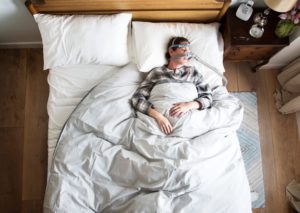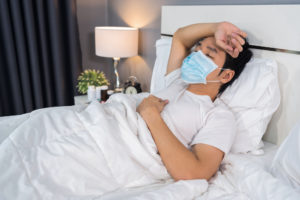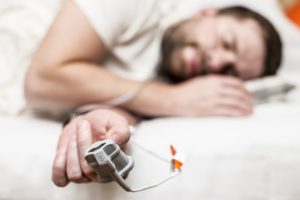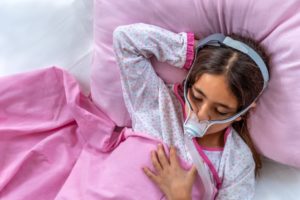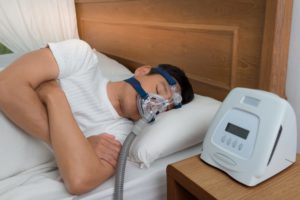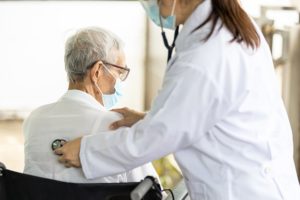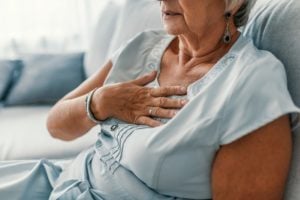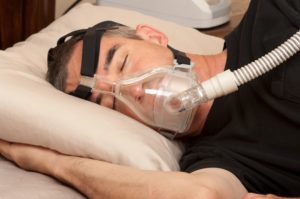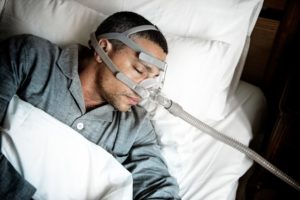Can You Die From Sleep Apnea?
Sleep apnea refers to several sleep disorders in which people have reduced or paused breathing during sleep. These repeated breathing disruptions can reduce sleep quality and contribute to serious health complications. Although treatment often resolves health risks tied to sleep apnea, if left unaddressed sleep apnea can be a life-threatening problem.
Learning about sleep apnea, as well as its potential effects on health and the benefits of treatment, can help people with sleep apnea understand this sleep disorder and how to work with their doctor to treat it most effectively.
Is Obstructive Sleep Apnea Linked to a Higher Risk of Death?
Obstructive sleep apnea (OSA) is the most common type of sleep apnea and affects between 10% and 30% of American adults. Multiple research studies have shown that people with OSA have a higher risk of all-cause mortality, which means that they are more likely to die of any cause when compared to people who do not have OSA. Untreated OSA has also been linked to an increased risk of death from cardiovascular problems.
Research suggests that the risk of mortality in people with sleep apnea may be linked to the severity of their breathing disruptions. Doctors classify the severity of OSA based on a person’s symptoms and their apnea-hypopnea index (AHI), which is calculated based on the number of breathing disruptions that occur during sleep. The risk of all-cause mortality has been found to be higher in people with more severe OSA .
Is Your Snoring a Health Risk?
Answer three questions to understand if you should be concerned.
Complications From Untreated Obstructive Sleep Apnea
Obstructive sleep apnea occurs when the upper airway becomes blocked by tissues in the mouth and throat. Obstructions to breathing can negatively affect health by influencing a person’s risk of several complications.
- Accidents: People with OSA get lower quality sleep, leading to daytime sleepiness and lack of concentration that makes them prone to accidents. Drowsy driving is more common in people with OSA, which can make potentially fatal car crashes more likely.
- Cardiovascular disease: The effects of OSA on the body are often seen in the cardiovascular system. For example, people with untreated OSA have been found to be more likely to have an abnormal heart rate, high blood pressure, heart attack, stroke, heart disease, and pulmonary hypertension.
- Type 2 diabetes: OSA can disrupt how the body manages blood sugar levels, raising the risk of type 2 diabetes, a condition that can cause a wide range of further health problems.
- Problems after surgery: People with OSA are more likely to have unintended postoperative side effects, including complications that can be life-threatening.
- Liver disease: Rates of nonalcoholic fatty liver disease are as many as three times as high in people with OSA. While not always linked to complications , this condition can cause liver damage, liver cancer, and ultimately liver failure.
Can You Die in Your Sleep From Obstructive Sleep Apnea?
Although uncommon, it is possible to die during sleep from untreated obstructive sleep apnea. Observational research has found that OSA increases a person’s risk of sudden death. This risk is believed to be higher in people of older age, in people with a critical illness, and in people with severe OSA.
Most of the time pauses in breathing from obstructive sleep apnea are just temporary. When changes in respiration cause oxygen levels to drop, a person partially awakens in order to restore breathing. However, there are rare reports of people dying because of an inability to properly reinitiate breathing.
When OSA is not treated, it can also interfere with the normal functions of the cardiovascular and nervous systems. This may provoke abnormalities in a person’s heart rhythms and other problems that can cause sudden cardiac death.
Can Treatment Reduce Complications of Obstructive Sleep Apnea?
Treatment can often eliminate or decrease the disruptions to breathing and sleep that are associated with obstructive sleep apnea. As a result, people who are effectively treated for OSA can avoid the heightened risk of complications and death linked to untreated OSA.
As an initial treatment of OSA, doctors often prescribed the use of a continuous positive airway pressure (CPAP) machine. A CPAP device sends pressurized air through a hose and mask to keep the upper airway open during sleep.
A study involving over 88,000 people compared health outcomes in people with OSA who started and continued using a CPAP machine versus people who started with a CPAP device but then stopped using it. Ongoing use of the CPAP device was associated with a significant decrease in the risk of all-cause mortality.
In the same study, the benefits of CPAP therapy were seen at follow-up after one year and after three years. Other research over a period of up to seven years also found a lower risk of death in people with OSA who regularly used a CPAP machine.
In order to effectively treat OSA with CPAP therapy, it is important to use the CPAP regularly. In general, this means wearing the CPAP for at least four hours per night on five or more nights of the week. Doctors and sleep specialists can work with people having difficulties tolerating CPAP by modifying the settings and accessories for CPAP therapy.

Central Sleep Apnea and the Risk of Death
Central sleep apnea (CSA) is much less common than OSA, and there are fewer studies about its effect on the risk of death. CSA involves an inability of the brain and respiratory muscles to properly regulate breathing and is frequently linked to underlying health problems , such as heart failure, that may affect a person’s expected lifespan.
In people with heart failure, having severe CSA has been linked to a higher risk of death . The risk of sudden death may be higher in people with severe CSA and heart failure because of the way that CSA can interfere with cardiovascular function.
For some people, treating the underlying cause of CSA can reduce or resolve breathing problems during sleep. Reestablishing normal breathing patterns may help enhance sleep quality and reduce other symptoms and complications of CSA.
Signs You May Have Sleep Apnea
Recognizing the signs of sleep apnea can help people know when to contact their doctor. Some of the most common signs and symptoms of sleep apnea include:
- Excessive daytime sleepiness, including falling asleep during times when it is normal to be awake
- Frequent snoring that is very loud
- Irregular breathing, including gasping or choking, during sleep
- Morning headaches
- Waking up with a sore throat or dry mouth
- Struggling with concentration or memory during the day
- Feeling unrefreshed despite sleeping for seven hours or more
Symptoms like snoring and restless sleep occur while a person is asleep, so people with sleep apnea may not be aware of their nighttime breathing issues. They may only learn of a potential problem when a bed partner, roommate, or family member tells them.
It is important to remember that it is not possible to diagnose sleep apnea based only on a person’s symptoms. Symptoms of sleep apnea can also be caused by other health issues, so diagnostic testing is required to determine if a person’s symptoms are caused by sleep apnea.
When to Seek Medical Advice
People with symptoms of sleep apnea, such as loud snoring, gasping during sleep, or excessive daytime sleepiness, should talk with their primary care doctor. The doctor can review their symptoms, sleep patterns, and overall health and recommend testing with a sleep study if necessary.
People who have already been diagnosed with sleep apnea should talk with their doctor or a sleep specialist if they have problems sticking with their treatment, have unwanted side effects of treatment, or find that treatment is not reducing their symptoms.
While untreated sleep apnea is associated with potentially life-threatening complications, working with a medical professional and closely following treatment recommendations can resolve many of these health risks.

Still have questions? Ask our community!
Join our Sleep Care Community — a trusted hub of sleep health professionals, product specialists, and people just like you. Whether you need expert sleep advice for your insomnia or you’re searching for the perfect mattress, we’ve got you covered. Get personalized guidance from the experts who know sleep best.
References
7 Sources
-
Kline, L. R. (2022, June 1). Clinical presentation and diagnosis of obstructive sleep apnea in adults. In N. Collop (Ed.). UpToDate., Retrieved September 25, 2022, from
https://www.uptodate.com/contents/clinical-presentation-and-diagnosis-of-obstructive-sleep-apnea-in-adults -
Mehra, R. (2021, August 25). Obstructive sleep apnea and cardiovascular disease in adults. In N. Collop (Ed.). UpToDate., Retrieved September 25, 2022, from
https://www.uptodate.com/contents/obstructive-sleep-apnea-and-cardiovascular-disease-in-adults -
Yaggi, H. K., Concato, J., Kernan, W. N., Lichtman, J. H., Brass, L. M., & Mohsenin, V. (2005). Obstructive sleep apnea as a risk factor for stroke and death. The New England Journal of Medicine, 353(19), 2034–2041.
https://pubmed.ncbi.nlm.nih.gov/16282178/ -
A.D.A.M. Medical Encyclopedia. (2021, April 22). Nonalcoholic fatty liver disease. MedlinePlus., Retrieved September 25, 2022, from
https://medlineplus.gov/ency/article/007657.htm -
Pépin, J. L., Bailly, S., Rinder, P., Adler, D., Benjafield, A. V., Lavergne, F., Josseran, A., Sinel-Boucher, P., Tamisier, R., Cistulli, P. A., Malhotra, A., Hornus, P., & medXcloud Group (2022). Relationship between CPAP termination and all-cause mortality: A French nationwide database analysis. Chest, 161(6), 1657–1665.
https://pubmed.ncbi.nlm.nih.gov/35176275/ -
Badr, M. S. (2021, September 30). Central sleep apnea: Risk factors, clinical presentation, and diagnosis. In R. Chervin (Ed.). UpToDate., Retrieved September 24, 2022, from
https://www.uptodate.com/contents/central-sleep-apnea-risk-factors-clinical-presentation-and-diagnosis -
Drager, L. F., McEvoy, R. D., Barbe, F., Lorenzi-Filho, G., Redline, S., & INCOSACT Initiative (International Collaboration of Sleep Apnea Cardiovascular Trialists) (2017). Sleep apnea and cardiovascular disease: Lessons from recent trials and need for team science. Circulation, 136(19), 1840–1850.
https://pubmed.ncbi.nlm.nih.gov/29109195/










